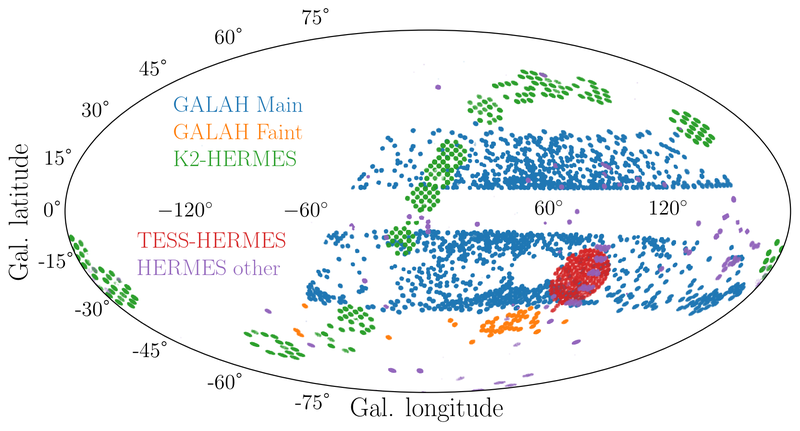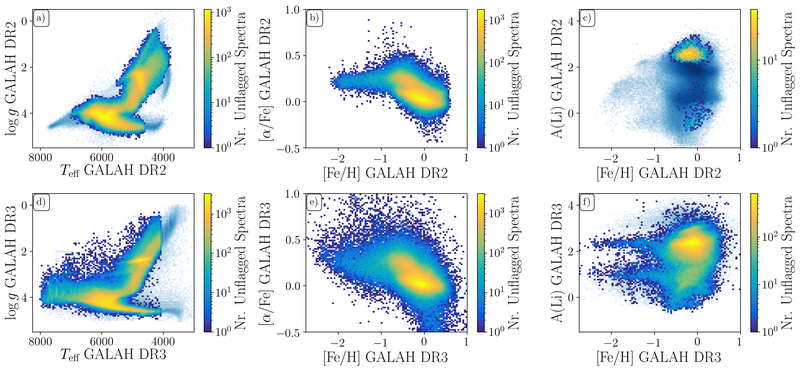GALAH+ Data Release 3 Overview
The Third Data Release of the Galactic Archaeology with HERMES (GALAH) survey provides one-dimensional spectra, stellar atmospheric parameters and individual elemental abundances for 678,423 spectra of 588,571 mostly nearby stars. They were observed with the HERMES spectrograph at the Anglo-Australian Telescope between November 2013 and February 2019. The release is fully described in Buder et al. (2021)
Want to start working right now with GALAH DR3?
We recommend the GALAH_DR3_main_allstar_v2.fits catalogue if you want our best effort stellar parameters and elemental abundances. This catalogue can be directly downloaded.
Please read our best practices for using GALAH DR3.
On this page
- Summary of GALAH DR3
- Data provided in GALAH DR3
- Sky Coverage
- The GALAH DR3 Data Products
- Changes from the Second Data Release of GALAH
- Need help?
Summary of GALAH DR3

- Our main catalogue comprises of data for 588,571 nearby stars. It is fully described on our Catalogue documentation.
- Our GALAH DR3 consists of 65% dwarfs and 34% giants, with the remaining 1% as unclassified stars.
- Based on stars with reliable chemical composition and age, we find 62.5% young low-alpha stars, 8.8% young high-alpha stars, 26.9% old stars, and 1.8% stars with [Fe/H] < -1. Based on kinematics, we find 4% halo stars.
- We provide the reduced one-dimensional spectra for the catalogued stars. It is fully described on our Spectra documentation.
- For ease of use, this release referred to as GALAH+ DR3 presents data from multiple programs as a single catalogue. It includes observations from:
- GALAH Phase 1 (bright, main, and faint survey, 476,863 spectra)
- the K2-HERMES (112,943 spectra)
- TESS-HERMES (34,263 spectra) surveys
- additional GALAH-related projects including the bulge and observations of more than 75 stellar clusters (54,354 spectra).
- Compared to GALAH DR2, we improve our spectrum analysis with external astro- and photometric information from Gaia DR2 and 2MASS to estimate more accurate stellar surface gravities, thus breaking spectroscopic degeneracies. We also use Spectroscopy Made Easy (SME) to analyse the entire spectral data set.
Data provided in GALAH DR3
For all the stars, we provide:
- Reduced one-dimensional spectra across the four wavelength regions of the HERMES spectrograph
- Barycentric radial velocities
- Stellar parameters (effective temperature, surface gravity, iron abundance, microturbulence, broadening)
- The overall alpha-element abundance, and up to 30 elemental abundances per star
- light elements: Li, C, O
- odd-Z elements: Na, Al, K
- α-elements: Mg, Si, Ca, Ti (and TiII)
- iron-peak elements: Sc, V, Cr, Mn, Co, Ni, Cu, Zn
- light and heavy slow neutron capture elements: Y, Ba, La, Rb, Mo, Ru, Nd, Sm
- rapid neutron capture element: Eu
- A number of value-added catalogues:
- Age, mass, distance estimates
- Galactic orbital properties
- Collated radial velocity measurements
- Binarity probabilities
Sky Coverage

The figure above displays the GALAH DR3 sky coverage in Galactic coordinates with the centre of the Galaxy at the origin. Shown are the GALAH Phase 1 targets (blue: main; orange: faint), which avoid the Galactic plane. The targets of the K2-HERMES follow-up (green) fall within with the K2 campaigns along the ecliptic and show the characteristic tile-pattern of the Kepler telescope. The TESS-HERMES observations (red) are focused on the TESS Southern Continuous Viewing Zone. Additional GALAH-related projects (purple) are distributed across the sky.
The GALAH DR3 Data Products
The two main data products of GALAH DR3 are the catalogue of stellar parameters & abundances, and the spectral library. We also provide several value-added catalogues.
GALAH DR3 Catalogues
For science cases involving stellar parameters, it is highly recommended that you use the GALAH_DR3_main_allstar_v2.fits table, and that you only consider stars where flag_sp == 0 and flag_fe_h == 0. For science cases involving the abundance of element X, it is highly recommended that you only consider x_fe where flag_x_fe == 0 and snr_c3_iraf > 30. Our Best Practices is a short guide of our recommendations for using GALAH DR3.
We provide two versions of the main GALAH DR3 catalogue:
GALAH_DR3_main_allstar_v2.fits(833 MB). Strongly recommend the use of this table for stellar parameters and abundances. It contains one entry per star, and has Radial velocity, stellar parameters and abundance data. Important data from Gaia, 2MASS, and WISE.GALAH_DR3_main_allspec_v2.fits(2.1 GB). This table is for expert use only. It is the extended catalogue of stellar parameters and abundances, with one entry per observation. It has radial velocity, stellar parameters for each observation. Also contains abundances derived for each individual line. Important data from Gaia, 2MASS, and WISE.
There are also several value-added catalogues:
- Gaia eDR3 data for all stars in GALAH DR3
- Ages, masses, distances and other parameters estimated by BSTEP
- Galactic kinematic and dynamic information
- Collated radial velocity measurements
- FGK binary stars
The Catalogue documentation provides details on the catalogues and how to acquire them.
GALAH DR3 Spectra
GALAH DR3 provides the reduced one-dimensional spectrum for each star in the main catalogue. These can be downloaded either individually or in bulk. Instructions on how to retrieve GALAH DR3 spectra can be found on the Spectra data access documentation page.
For each star there are four files, one for each of the four HERMES cameras, with each spectrum file containing the:
- reduced spectrum
- relative error of spectrum with sky subtraction.
- pseudo-continuum normalized spectrum
- variance of the pseudo-continuum normalized spectrum
- sky spectrum used for sky subtraction
The Spectra documentation provides details on the spectra and how to acquire them.
Changes from the Second Data Release of GALAH
Data Reduction
There have been two major improvements to the data reduction:
- The main improvement is the wavelength solution, which is now more stable at the edges of green and red CCDs, where we lack arc lines. This has been achieved by monitoring the solution and fixing the polynomial describing the pixel-to-wavelength transformation, if deviations from a typical or average solution are detected.
- Cross-talk is now parametrized differently. It can only be measured in larger gaps between every 10th spectrum.
There are two main changes to the analysis methods for DR3 compared to DR2:
- We are using astrometric information from Gaia DR2 to break spectroscopic degeneracies. This requirement has resulted in about 5000 stars that were in GALAH DR2 not being in GALAH DR3. See the data reduction and analysis documentation for more details.
- GALAH DR3 uses Spectroscopy Made Easy for all the stellar parameter and elemental abundance determination. For the second data release of the GALAH survey we made use of data-driven approaches to improve both speed and precision of the spectroscopic analysis. Although the data-driven approaches were successful for the majority of GALAH DR2 stars, we know that these approaches can suffer from signal aliasing, they can learn unphysical correlations between the input data and the output stellar labels, and the results are not necessarily valid outside the parameter space of the training set. We found in DR2 that the data-driven approaches meant that stars at the periphery in stellar label space, e.g. high temperature or low metallicity did not receive optimal labels from the data driven process.
Below is a comparison of GALAH DR2 (upper panels) and GALAH DR3 (lower panels, this release). The smooth light blue background indicates all measurements, whereas the colormap shows the number of unflagged measurements at each point. The stellar parameters and abundances from GALAH DR2 appear more tightly constrained, but we note that this is an artefact of the data-driven approach, which tends to find solutions closer to the mean parameter/abundance patterns.

Need help?
Questions about GALAH DR3 that are not answered in the documentation? Contact us:
- Email galah.helpdesk@gmail.com
- Twitter: @galahsurvey
